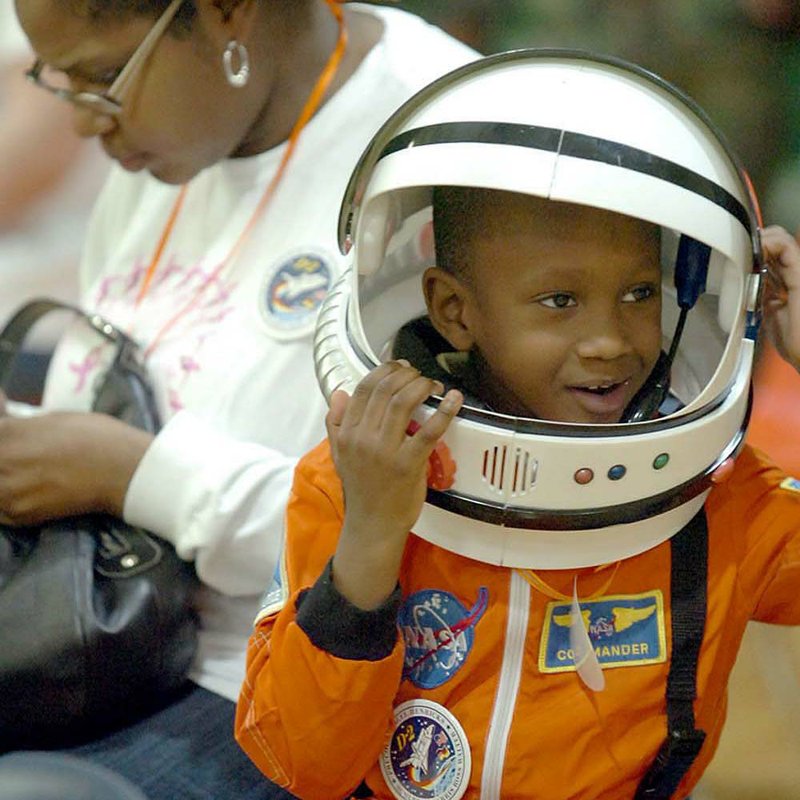LITTLE ROCK — Being an astronaut on a space shuttle flight is like being Superman, Dr. Bernard Harris Jr., a crew member on two such shuttle flights in the 1990s, told pupils Monday at Little Rock’s Cloverdale Aerospace Technology Conversion Charter Middle School.
While the fictional Superman can fly faster than a speeding bullet and leap tall buildings in a single bound, the real-life Harris said that when he was on the Columbia and Discovery space shuttles, he flew 250 nautical miles above Earth at 17,500 miles per hour.
And while Superman is described as being “more powerful than a locomotive,” Harris - who in 1995 became the first black man to walk in space - launched a 3,500-pound satellite “with these two hands.”
Harris’ message to the assembly of Cloverdale pupils was that his education, which includes a bachelor’s degree, two master’s degrees, a medical degree and a residency in internal medicine at the Mayo Clinic, gave him the opportunity to be an astronaut for 10 years.
Being an astronaut was something that he f irst dreamed of doing at age 13 in 1969 when he saw Neil Armstrong and Edwin “Buzz” Aldrin become the first human beings to walk on the moon.
Cloverdale students have that same potential to be whatever they want to be if they acquire the necessary education, he said.
“You are a being with infinite possibilities,” Harris told them. He also said he believes that “each and every one of us was born to do something special.”
Harris, 54, lived his first six years in the inner city of Houston. His parents divorced and he lived with his mother - a teacher - in the Navajo Nation, which covers parts of New Mexico and Arizona, before he graduated from high school in San Antonio. He ultimately attended medical school at Texas Tech University School of Medicine.
When he applied to NASA, he was one of 6,000 to do so. He was one of 150 to be interviewed and one of 23 to be selected for the program, which started with two years of training.
He was a mission specialist on a 1993 Space Shuttle Columbia flight and payload commander on a 1995 Space Shuttle Discovery flight that went to the Russian Space Station.
Wearing a sky-blue jumpsuit adorned with assorted patches, Harris on Monday took questions from pupils who asked if astronauts made a lot of money, whether anything bad happened on his flights, what his space suit cost and how space travel affected the human body.
To that last question, the physician said that space travelers lose muscle and bone, and their hearts become smaller. Upon returning to Earth it takes an hour or so for an astronaut to regain the ability to stand, and two weeks to a month to “get back to normal.”
Asked what astronauts do for fun, Harris said they sometimes play with their food. He recalled one crew allowing M&M candy pieces to float loose in the cabin and then, mimicking fish, crew members floated after the candy to eat it.
“We went around the world every 90 minutes. We get the chance to see a sunrise or sunset every 45 minutes. It was pretty awesome. I liked being an astronaut. It’s pretty cool.
“And the views are just incredible, the things we see. I got to see the Great Wall of China from space. I saw the Sahara Desert from space.”
But Harris said most of the astronauts’ time is devoted to completing a schedule of tasks.
On his first mission, for example, he said he conducted 91 different experiments, including some with fish and tadpoles taken on board. His second mission included his space walk and the launching of a satellite.
Harris left NASA in 1996. Among his other initiatives, Harris is the founder and president of The Harris Foundation, which is a partner in the ExxonMobil Bernard Harris Summer Science Camp held at 30 colleges and universities, including the University of Arkansas at Little Rock, for middle-school students.
He said in an interview he is not dismayed by NASA’s plan to retire the space shuttles at the end of this year.
“By no means is it closing down,” he said about space travel. “We are just going in a new direction.
“It will become not government-led but a public private partnership for space. Of course, there will be some growing pains as we make this transition. But I think in the long run it will be good for the space industry and manned space flights.”
U.S. Rep. Vic Snyder, DArk., attended the student assembly Monday, as did Little Rock City Manager Bruce Moore and Little Rock School Board members Dianne Curry and Charles Armstrong.
Cloverdale students said after the speech that they were glad to have Harris visit their school.
“It was an honor for him to come to this school and tell us what it was like for him in space,” said Jesus Fletes, who said he has “always” watched space shuttle launches and landings. He wants to be a surgeon.
Eighth-grader Cameron Cook marveled at shaking history-maker Harris’ hand and said he now believes he wants to be a pilot.
Willie Vinson, Cloverdale principal, bought 160 copies of Harris’ book Dream Walker: A Journey of Achievement and Inspiration and made it the Principal’s Book of the Month selection for November after learning that Harris would visit the school. As the book of the month, teachers throughout the school read aloud from the book to students.
“I wanted the kids to know the significance of his coming,” Vinson said.
Arkansas, Pages 9 on 11/23/2010
